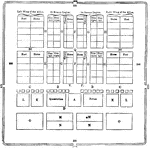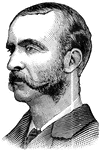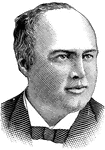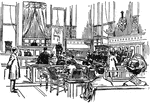
Red House
The Red House. The "Red House" is situated upon the street in Wilkesbarre next the river, and about…

Catapult
"Catapult from the Roman military system. The Roman army was divided into legions, each of which contained…

Martin Luther
"Martin Luther was born at Eisleben in 1483. He was the son of a poor miner, had entered the Augustinian…
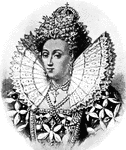
Queen Elizabeth
"Queen Elizabeth was the daughter of Henry VIII, by Anne Boleyn. Her reign is one of the most remarkable…

Alimentary Canal
"The digestive sac, tract, or tube of any animal; the visceral or intestinal cavity."-Whitney, 1902
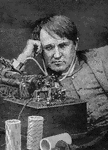
Thomas Alva Edison
"Thomas Alva Edison was born at Milan, Ohio, February 11, 1847, but the family soon after moved to Port…

Block and Tackle
"A Block is a pulley or a system of pulleys rotating on a pintle mounted in its frame or shell with…
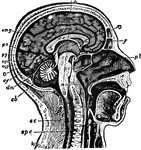
Human Brain
"The Brain is the encephalon, or center of the nervous system and the seat of consciousness and volition…
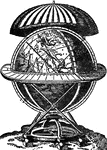
Globe of Copernicus
"Copernicus, or Nicholas Koppernigk, was the founder of modern astronomy. From a school in Thorn Copernicus…

Maxim’s Flying Machine
"A Flying Machine is a device for enabling man to navigate the air. The feat of flying has been often…

Wireless Telegraph Transmitter
"Wireless Telegraphy is a system of transmitting messages between distant points without the use of…
Wireless Telegraph Receiver
"Wireless Telegraphy is a system of transmitting messages between distant points without the use of…
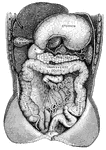
Digestive system
"Showing the Relations of the Stomach, Liver, Intestines, Spleen, and other Organs of the Abdomen. Aduodenum;…

Nervous System
"Diagram illustrating the General Arrangement of the Nervous System. (posterior view.)" — Blaisedell,…

Sarcophagus of Scipio
"Sarcophagus, plural Sarcophagi, is a kind of stone used among the Greeks for making coffins, and so…
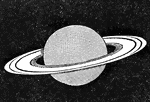
Saturn
"Saturn is the 6th of the major planets in order of distance from the sun, and the outermost known to…
Tapeworm
"The Tapeworm is an intestinal worm, Tænia solium, in form somewhat resembling tape. Its length…
!["The Tapeworm is an intestinal worm, Tænia solium, in form somewhat resembling tape. Its length is from 5 to 15 yards, and its breadth from two lines at the narrowest part to four or five at the other or broader extremity. At the narrow end is the head, which is terminated anteriorly by a central rostellum, surrounded by a crown of small recurved hooks, and behind them four suctorial depressions; then follow an immense number of segments, each full of microscopic ova. The segments are capable of being detached when mature, and reproducing the parasite. There is no mouth; but nutrition appears to take place through the tissues of the animal, as algæ derive nourishment from the sea water in which they float. The digestive system consists of two tubes or lateral canals, extending from the anterior to the posterior end of the body, and a transverse canal at the summit of each joint. [Pictured] A single segment or proglottis magnified; 1, generating pore; 2, water vessels; 3, dendritic ovary."—(Charles Leonard-Stuart, 1911)](https://etc.usf.edu/clipart/16500/16595/tapeworm2_16595_mth.gif)
Tapeworm
"The Tapeworm is an intestinal worm, Tænia solium, in form somewhat resembling tape. Its length…
!["The Tapeworm is an intestinal worm, Tænia solium, in form somewhat resembling tape. Its length is from 5 to 15 yards, and its breadth from two lines at the narrowest part to four or five at the other or broader extremity. At the narrow end is the head, which is terminated anteriorly by a central rostellum, surrounded by a crown of small recurved hooks, and behind them four suctorial depressions; then follow an immense number of segments, each full of microscopic ova. The segments are capable of being detached when mature, and reproducing the parasite. There is no mouth; but nutrition appears to take place through the tissues of the animal, as algæ derive nourishment from the sea water in which they float. The digestive system consists of two tubes or lateral canals, extending from the anterior to the posterior end of the body, and a transverse canal at the summit of each joint. [Pictured] Head of tænia solium (enlarged)."—(Charles Leonard-Stuart, 1911)](https://etc.usf.edu/clipart/16500/16599/tapeworm3_16599_mth.gif)
Tapeworm
"The Tapeworm is an intestinal worm, Tænia solium, in form somewhat resembling tape. Its length…
!["The Tapeworm is an intestinal worm, Tænia solium, in form somewhat resembling tape. Its length is from 5 to 15 yards, and its breadth from two lines at the narrowest part to four or five at the other or broader extremity. At the narrow end is the head, which is terminated anteriorly by a central rostellum, surrounded by a crown of small recurved hooks, and behind them four suctorial depressions; then follow an immense number of segments, each full of microscopic ova. The segments are capable of being detached when mature, and reproducing the parasite. There is no mouth; but nutrition appears to take place through the tissues of the animal, as algæ derive nourishment from the sea water in which they float. The digestive system consists of two tubes or lateral canals, extending from the anterior to the posterior end of the body, and a transverse canal at the summit of each joint. [Pictured] A, ovum with contained embryo, B, Cystericus longicollis."—(Charles Leonard-Stuart, 1911)](https://etc.usf.edu/clipart/16600/16600/tapeworm4_16600_mth.gif)
Tapeworm
"The Tapeworm is an intestinal worm, Tænia solium, in form somewhat resembling tape. Its length…
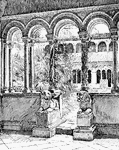
Cloister of the Lateran
"The Benedictine system enjoined three virtues as essential; solitude, humility, and obedience." —…

Cavalier
What a Cavalier wore. The name Cavalier originally related to political and social attitudes and behaviour,…

Abram Stevens Hewitt
Hewitt was a congressman, major of New York City, teacher, iron manufacturer, and lawyer.
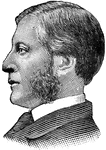
Charles W. Eliot
Educator who became president of Harvard and presided over a period of great growth which included the…
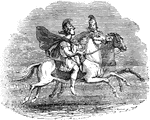
Theseus and Helen
"In the year 1234 B.C., Theseus came to the throne of Athens. He was one of the most renowned characters…

Lymphatic Vessels in the Fingers
"Among the cells of the body there is, besides the blood capillaries, a system of fine, thin-walled…
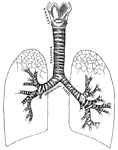
Respiratory system
"Larynx, trachea, and bronchi, showing the manner of division, and the rings of cartilage." —…

Central Nervous System
"Brain and spinal cord, with the thirty-one pairs of spinal nerves." — Tracy, 1888
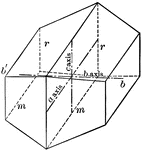
Crystal of the monoclinic system
"A crystal form does not necessarily make a solid figure. One such an example is this, of the Monoclinic…

Symmetry of Sphenoidal class
"The Sphenoidal Class corresponds in the Tetragonal system to the Tetrahedral class in the Isometric…

Symmetry of normal class
"The symmetry of the Normal Class of the Hexagonal System is as follows: The vertical crystallographic…
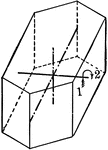
Symmetry of monoclinic system
"The symmetry of the Monoclinic System is as follows: The crystallographic axis b is an axis of binary…
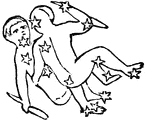
Gemini
"The third sign of the zodiac, so named from its 2 brightest stars, Castor, of the 1st magnitude, farthest…

Snail
"Soft unsegmented bodies, bilaterally symmetrical, enveloped by a leathery mantle, which usually develops…
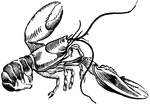
Lobster
"Bilaterally symmetrical bodies composed of a series of rings or segments, each of which bears a pair…

Thurlow Weed
"From the most humble origin Thurlow Weed rose by slow degrees until he became one of the leading journalists…
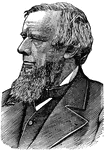
Allen G. Thurman
"Ex-Senator Allen G. Thurman, of Ohio, a gentleman held in the highest esteem by both political parties,…

A Dutch Patroon
In the United States, a patroon was a landholder with manorial rights to large tracts of land in the…

Cavalier
Example of the Cavalier style of clothing. The name Cavalier originally related to political and social…

Kidney
Two glands having the function of secreting urine from the system, situated at the back of the abdominal…

Druids
"The Druidical system was at the height of at the time of the Roman invasion uner Julius Caesar. Against…

Sympathetic Nervous System
"Part of the sympathetic nervous system seen from in front, n, one of the two chief cords, t, i, and…








